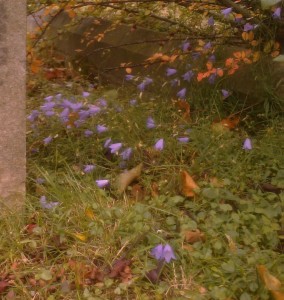A small patch of Harebell (Campanula rotundifolia) was found by myself on my first ever visit to the churchyard of All Saints on Rectory Lane on October 22nd, with two flowers still open and several empty seed heads. Being right up against a raised grave, this particular patch had escaped cutting. There appeared to be other, unflowered, plants in the grass. The church sits within the River Cray Metropolitan Site of Importance for Nature Conservation (M106). The previous record of this species hereabouts that is held by Greenspace Information for Greater London (the London biological records centre) was made by the famous botanist Francis Rose (no relation I know of) back in 1955. He only gave co-ordinates for the corners of larger map squares, so we cannot tell if he specifically looked at the churchyard, but he does seem to have recorded the plant over a greater area than it seems to occupy now. Indeed Harebell has now become rather rare in the capital. There are six known sites in Bexley, 4 of which are historic cemeteries, which provide a refuge for this and other species of old grassland that have doubtless been eradicated elsewhere by ‘development’, re-seeding with monocultures of hard-wearing grasses and intensive recreational usage.

The cemetery at Christchurch, Bexleyheath, is one of four graveyards hosting Harebell in Bexley, a species now rare in London. It has also been found at Bexleyheath Golf Course and Hall Place North. (Photo: Chris Rose)
Also in the older part of this churchyard, where burials date from the late 1700s and the 1800s, were a good number of species of colourful ground-dwelling fungi. Throughout the grounds there was a large amount of Mouse-ear Hawkweed and Germander Speedwell, also some Sorrel and a patch of Knotted Hedge Parsley, but apparently only one plant of Ladies Bedstraw. Unusually for a cemetery in Bexley, there was not one grave with any species of Sedum growing on it.
Seven plants of the small fern Asplenium ruta-muraria were noted growing around a side wall buttress of All Saints, whilst earlier some 53 plants of Asplenium trichomanes were counted on the inside of the wall of St. John’s church near Sidcup High Street. Both species are found at only a handful of other sites – largely old walls – in our relatively dry Borough. St. John’s churchyard also boasts quite a lot of Germander Speedwell, and four galls on this plant caused by the Gall Midge, Jaapiella veronicae were noticed.
Chris Rose

Its out of the borough I know, but there are lots of harebells on the common in Chislehurst, and in the church yard of St Nicholas’s. Do they prefer that rough grassy environment I wonder?